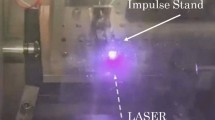Abstract
Development of pulsed lasers for space-based science missions entail many additional challenges compared to terrestrial experiments. For systems requiring short pulses ≪1 ns with energies >100 mJ and fast repetition rates >10 kHz there are currently few if no laser architectures capable of operating with high electrical efficiency >20% and have good system stability. The emergence of a mulit-channel fiber-based Coherent-Amplifying-Network or CAN laser potentially enables such capability for space based missions. Here in this article we present an analysis of two such missions scaling up in pulse energy from ≈100 mJ for a supercontinuum LIDAR application utilising atmospheric filamentation to the higher energy demands needed for space debris remediation requiring ≈10 J pulses. This scalability of the CAN laser provides pathways for development of the core science and technology where many new novel space applications can be made possible.
Similar content being viewed by others
References
T. Fujii, T. Fukuchi (eds.), Laser remotesensing (CRC Press, 2005)
eLISA Consortium., Nat. Phys. 11, 613 (2015)
R.J. DeYoung, et al., A NASA high-power space-based laser research and applications program. NASA STI/Recon Technical Report N 83, 27200 (1983)
A. Novo-Gradac, et al., An overview of NASA’s laser risk reduction program. Geoscience and Remote Sensing Symposium, 2004, IGARSS’04, Proceedings, 2004 IEEE International, Vol. 1, IEEE (2004)
G. Mourou, et al., Nat. Photonics 7, 258 (2013)
J. Prawiharjo, et al., Opt. Expr. 16, 15074 (2008)
R. Soulard, M.N. Quinn, G. Mourou, Appl. Opt. 54, 4640 (2015)
W.S. Brocklesby, et al., Eur. Phys. J. Special Topics 223, 1189 (2014)
G. Mourou, et al., Are fibe-based lasers the futureof accelerators? Nuclear Instruments and Methods in Physics Research Section A: Accelerators, Spectrometers, Detectors and Associated Equipment 740, 17 (2014)
J. Bourderionnet, C. Bellanger, J. Primot, A. Brignon, Opt. Expr. 19, (2011)
A. Braun, G. Korn, X. Liu, D. Du, J. Squier, G. Mourou, Opt. Lett. 20, 73 (1995)
V. Jukna, et al., Space-based Femtosecond Laser Filamentation, ESA Ariadna final report 13-9291 (2015)
M. Berger, et al., Remote Sens. Environ. 120, 84 (2012)
T. Wagner, et al., J. Opt. A: Pure Appl. Opt. 10, 104019 (2008)
R. Bourayou, et al., J. Opt. Soc. Am. B 22, 369 (2005)
J. Kasparian, M. Rodriguez, G. Méjean, J. Yu, E. Salmon, H. Wille, R. Bourayou, S. Frey, Y.-B. André, A. Mysyrowicz, R. Sauerbrey, J.-P. Wolf, L. Wöste, Science 301, 61 (2003)
C. Bellanger, et al., Opt. Lett. 35, 3931 (2010)
J.-C. Liou, P. Krisko, N update on the effectiveness of postmission disposal in leo, in: Proceedings of the 64th International Astronautical Congress, IAC-13-A6.4.2 (Beijing, China, 2013)
D.J. Kessler, B.G. Cour-Palais, J. Geophys. Res. Space Phys. 83, 2637 (1978)
D.J. Kessler, Adv. Space Res. 11, 63 (1991)
J.-C. Liou, Adv. Space Res. 47, 1865 (2011)
Wormnes , Kjetil, et al., ESA technologies for space debris remediation, Proceedings of the 6th IAASS Conference: 22–25 April (2013)
C. Phipps, AIP Conf. Proc., 318 (1994)
W.O. Schall, Proc. SPIE 3574, 426 (1998)
C. Phipps, et al., J. Propulsion Power 26, 609 (2010)
C. Phipps, et al., Appl. Surface Sci. 252, 4838 (2006)
T. Ebisuzaki, et al., Acta Astronautica 112, 102 (2015)
Y. Takahashi, et al., New J. Phys. 11, 065009 (2008)
R. Soulard, et al., Acta. Astronaut. 105, 192 (2014)
C.R. Phipps, Acta Astronaut. 104, 243 (2014)
A.W. Yu, et al., Fiber lasers and amplifiers for space-based science and exploration. SPIE LASE, International Society for Optics and Photonics (2012)
B. Weeden, Space Policy 27, 38 (2011)
A. Klenke, S. Breitkopf, M. Kienel, Opt. Lett. 38, 2283 (2013)
L. Daniault, et al., Eur. Phys. J. Special Topics 224(13), 2609 (2015)
Author information
Authors and Affiliations
Corresponding author
Rights and permissions
About this article
Cite this article
Quinn, M.N., Jukna, V., Ebisuzaki, T. et al. Space-based application of the CAN laser to LIDAR and orbital debris remediation. Eur. Phys. J. Spec. Top. 224, 2645–2655 (2015). https://doi.org/10.1140/epjst/e2015-02577-5
Received:
Revised:
Published:
Issue Date:
DOI: https://doi.org/10.1140/epjst/e2015-02577-5




